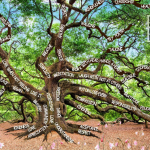The Timeless Call to Wholeness
There is a truth that does not age, fracture, or fade with time. It speaks not only through scripture or philosophy, but through the very heartbeat of life itself a truth Gandhi called Ahimsa, and Adi Da revealed as Prior Unity. In a world increasingly tangled in fragmentation, this truth emerges again and again as the medicine for disconnection: We are not separate.
In its truest form, Ahimsa does not merely mean refraining from violence. In Sanskrit, “Himsa” refers to the desire or intention to harm. The prefix “A” negates it thus, Ahimsa means the absence of any desire to harm. It is a state of pure harmlessness that arises naturally from the recognition of our unity with all that lives.
Ahimsa, often translated simply as “nonviolence,” is not the absence of harm, but the living presence of wholeness. It is a force, a conscious current that flows through all that lives. Gandhi discovered this not as a political tool but as a sacred law of Being. Adi Da illuminated the same truth from a different doorway: not as morality, but as the very structure of Reality.
The Lineage of Peace Is Not One Line, But a Circle
What is often called a lineage is not merely a succession of teachers and students, but a deep rhythm echoing through the soul of humanity. Gandhi did not invent Ahimsa; he remembered it. Adi Da unveiled what Is already, always the case.
From the ancient seers of India to the mystics of the desert and the bodhisattvas of compassion, there runs a luminous thread: reality is inherently unified. Violence, then, is not merely a harmful act, it is a false view. It sees two where there is only one.
Gandhi walked this understanding through action whether spinning cotton or facing oppression. Adi Da expressed it as radical insight: that the “self” we protect and defend is an illusion, and that true peace arises not from fixing the world but from transcending the illusion of separateness.
Presence as the Only Power
Both Gandhi and Adi Da taught, in their own ways, that peace is not the result of struggle, but of presence. This is the great reversal: modernity teaches us to build toward a better future, but Ahimsa whispers that the future begins now, in how we breathe, speak, listen, and live.
Ahimsa does not wait for peace talks or policy. It does not depend on outer conditions. It arises wherever the illusion of “other” dissolves. It is being peace rather than demanding peace.
In this way, the “activism” of Ahimsa is not passive, it is fierce in its gentleness. To live without enmity in a world trained in division is an act of great power.
From Past to Future: The Shape of Now
Looking back, we see Gandhi walking barefoot toward empire and turning it into dust. We see Adi Da, Radiant in silence, pointing to the Bright as the true nature of existence. But these are not relics of the past, they are living invitations.
The future of Ahimsa does not belong to history books or gurus. It belongs to each of us who are willing to remember. The way forward is not “ahead” it is deeper into the present, where peace is not an idea but a pulse.
From eco-dwellings in India where Arun “Appaji” Gandhi’s ashes rest, to classrooms lit by compassion, to children in Brazil learning nonviolence anew, the lineage continues, not as tradition, but as transmission.
The Invitation of Indivisibility
We are not here to perfect the world as separate selves. We are here to remember that the world was never separate to begin with.
This is the dharma of Ahimsa, not as belief, but as reality. Gandhi’s courage and Adi Da’s wisdom both point to this: Indivisibility is not a dream to achieve; it is the truth to recognize.
And when we do, when we live from this recognition, in each action, meal, step, and silence the future bends toward wholeness, and peace is no longer a goal. It is the ground.
With Ahimsa,
Donate to Keep the Peace Growing –
https://givebutter.com/26KJ34







Speak Your Mind